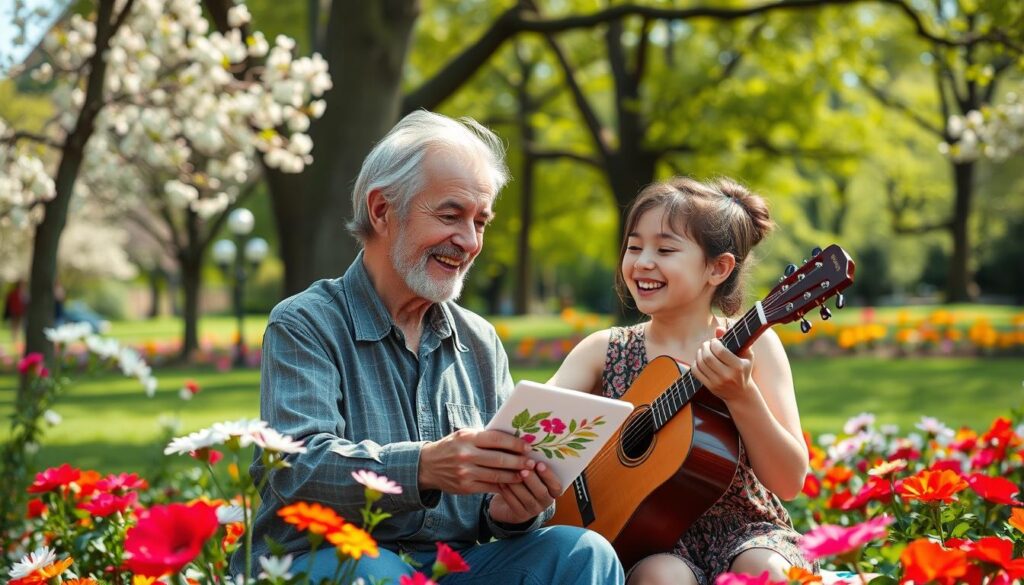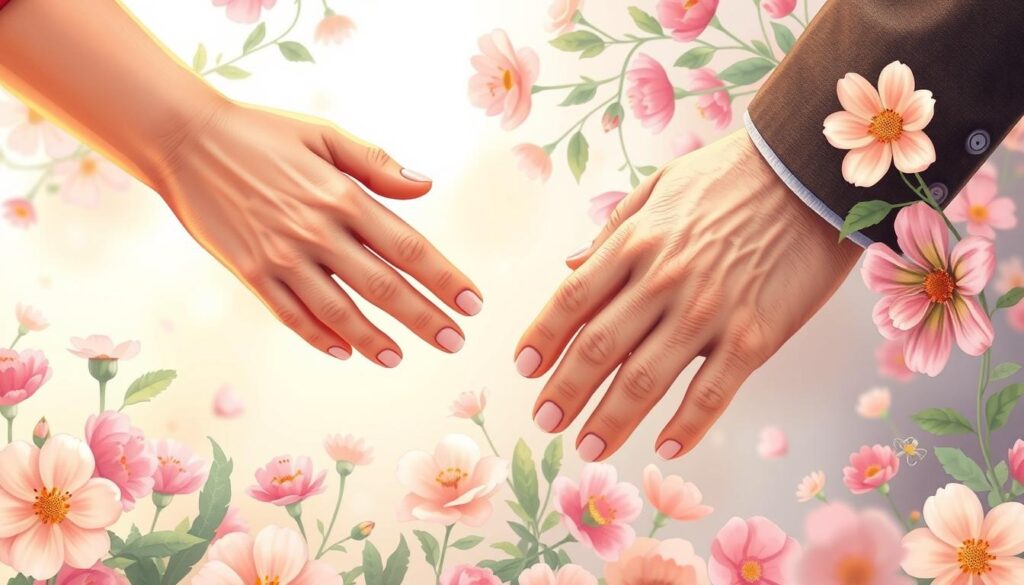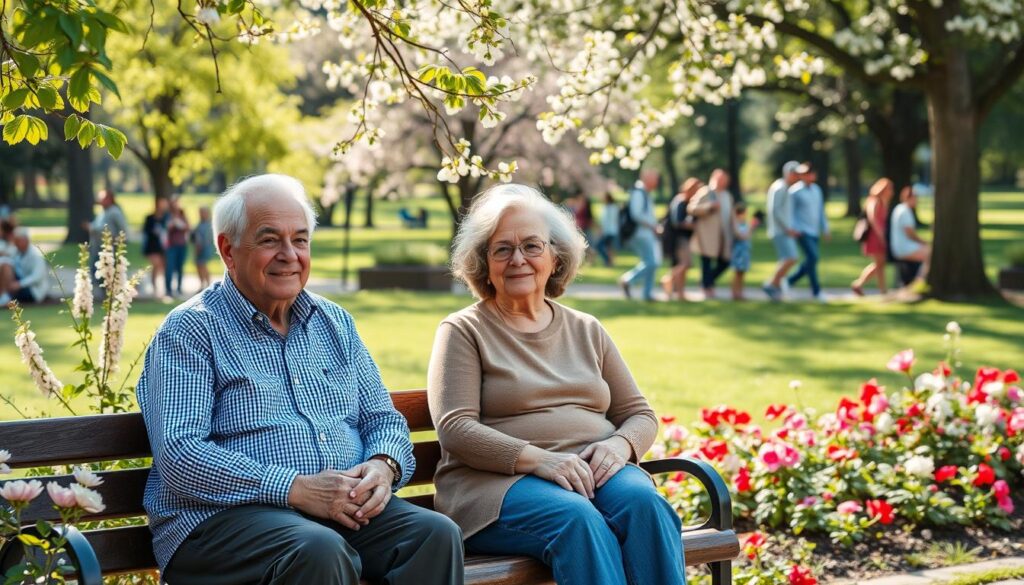
Age-gap relationships, where there is a significant difference in age between partners, often raise eyebrows and face social stigma. However, research suggests there can be surprising benefits to these types of relationships. Studies have found that couples with more than a ten-year age gap often report higher relationship satisfaction, greater trust and commitment, and lower jealousy than similar-age couples. Some researchers believe age-gap relationships can lead to personal growth, new perspectives, and lasting happiness for both partners. While there are unique challenges, such as navigating power dynamics and life stage differences, many age-gap couples find ways to overcome the stigma and thrive.
Key Takeaways
- Age-gap relationships can offer surprising benefits, including higher relationship satisfaction and greater trust and commitment.
- Researchers suggest that age-gap relationships can foster personal growth and new perspectives for both partners.
- While there are challenges, many age-gap couples can overcome social stigma and find lasting happiness together.
- Factors like financial security, communication skills, and emotional intelligence can contribute to the success of age-gap relationships.
- An age gap of 1 to 3 years is considered ideal in many cultures for relationship satisfaction.
What is an Age Gap Relationship?
Age-gap relationships refer to romantic partnerships where there is a significant difference in the ages of the partners, typically at least 10 years. These types of relationships can involve an older man with a younger woman, an older woman with a younger man, or same-sex couples with a large age disparity. While the specific age gap that defines an “age-gap” relationship can vary across cultures, the phenomenon of intergenerational romance is observed globally.
Defining Age-Gap Relationships
Sociologists and psychologists have studied the prevalence, dynamics, and societal perceptions of age-gap relationships, seeking to understand the factors that draw some people to pursue partnerships with large age differences. Across Western countries, about 8% of all married heterosexual couples can be classified as having a large age gap (ten years or more), mainly involving older men partnered with younger women. About 1% of age-gap couples involve an older woman partnered with a younger man. In same-sex couples, the rates are higher, with around 25% of male-male unions and 15% of female-female unions demonstrating a large age gap.
| Relationship Type | Prevalence of Large Age Gap (10+ Years) |
|---|---|
| Heterosexual Couples | 8% |
| Older Woman – Younger Man | 1% |
| Male-Male Couples | 25% |
| Female-Female Couples | 15% |
The prevalence of age-gap relationships, their dynamics, and societal perceptions continue to be a topic of interest for researchers examining the benefits of age gap love, intergenerational romance, and the unique challenges faced by older partner younger partner dynamics in May-December relationships and cougar relationships.
Prevalence of Age Gap Couples
While age differences in relationships may raise eyebrows, the prevalence of intergenerational romance is more common than you might think. Across Western countries, about 8% of all married heterosexual couples can be classified as having a large age gap of ten years or more, generally involving an older man and a younger woman. The trend is even more pronounced in certain non-Western cultures, where up to 30% of unions in some African countries reflect a significant age difference between partners.
The phenomenon extends beyond just heterosexual pairings. Same-sex couples also exhibit higher rates of age-gap relationships, with about 25% of male-male unions and 15% of female-female unions demonstrating a large age difference between partners. These statistics suggest that age differences in relationships are more widespread than commonly perceived, challenging the notion that such arrangements are rare or unnatural.
| Relationship Type | Age Gap Prevalence |
|---|---|
| Heterosexual Couples (Western Countries) | 8% with a 10+ year age gap |
| Non-Western Couples (Some African Countries) | Up to 30% with a significant age gap |
| Male-Male Couples | 25% with a large age gap |
| Female-Female Couples | 15% with a large age gap |
These statistics suggest that age differences in relationships, often referred to as “May-December” or “intergenerational” romances, are more common than commonly believed. Challenging societal stigma, these numbers reveal a more nuanced and diverse landscape when it comes to age-gap couple dynamics and the prevalence of intergenerational dating across different cultural contexts.

What are the benefits of being in an age gap relationship
While age-gap relationships may face societal stigma and unique challenges, research suggests there are several potential benefits for the couples involved. From higher reported relationship satisfaction to greater trust and commitment, these unconventional partnerships can foster personal growth, new perspectives, and lasting happiness.
One notable example is the case of Jessica Moss and Kevin Hardesty, who have navigated a 19-year age gap in their relationship. Similarly, stand-up comedian Dane Cook, 51, made headlines for marrying a 24-year-old Pilates instructor, sparking discussions around the pros and cons of age-gap romances. Even Hollywood icons like Audrey Hepburn have frequently depicted relationships with significantly older men, reflecting a societal norm.
Couples with a significant age difference can bring a unique dynamic to their partnership. Older partners may provide stability and maturity, while younger spouses can offer energy and fresh perspectives. For couples where the wife is older, the woman tends to be more decisive, leading to fewer mixed messages. Older partners are also often more understanding of their younger spouse’s needs.
| Potential Benefits of Age Gap Relationships | Examples |
|---|---|
| Higher relationship satisfaction | The author and her husband, with an 11-year age gap, have been together for 20 years and celebrated their 13th wedding anniversary. |
| Greater trust and commitment | Jane and Fred, a couple with a 31-year age gap, explored unconventional relationship dynamics during the pandemic. |
| Lower levels of jealousy | Women in large age-gap relationships report being the most satisfied with their love lives. |
| Opportunity for personal growth and new perspectives | Combining wisdom and energy can be a healthy exchange in age-gap relationships. |
While navigating power dynamics and life stage differences can pose challenges, many age-gap couples find ways to overcome these obstacles and thrive in their relationships. The success of such partnerships often relies on trust, commitment, and respect rather than age alone.
Perceived Evolutionary Advantages
Evolutionary psychologists have proposed that the preferences for age differences in romantic relationships may be rooted in reproductive fitness. The idea is that men are often attracted to younger women due to their perceived fertility and youth, while women tend to value the status, resources, and maturity that often come with an older partner.
Men’s Preferences for Younger Women
This evolutionary explanation suggests that older men may be drawn to younger partners because they represent higher fertility and longer reproductive windows. At the same time, younger women may be attracted to the stability and resources that older men can offer. However, these theories do not fully explain the prevalence of age-gap relationships, including same-sex couples and situations where the woman is significantly older than the man, highlighting the complex interplay of biological, social, and cultural factors.
Research indicates that heterosexual couples tend to differ in age by about three years, with men usually being the older partners. However age gaps between partners can vary widely, from 15 years to 25 years, leading to significant public attention and potential discomfort within the relationship.
| Key Findings | Details |
|---|---|
| Men’s Preferences |
|
| Women’s Preferences |
|
| Remarriage Patterns |
|
The success of age-gap relationships may rely on factors beyond chronological age, such as shared interests, vitality, energy levels, and overall compatibility, which can contribute to a satisfying partnership regardless of the age difference.

Relationship Dynamics and Challenges
One of the primary challenges in age-gap relationships is navigating the potential power imbalance and differences in life stages between partners. Younger partners, especially those in their 20s and 30s, may feel dependent on their older partner’s financial or professional status, which can create power dynamics that must be carefully managed.
Couples with large age gaps may also face difficulties reconciling their differing life goals, priorities, and experiences, as they may be in vastly different stages of their personal and professional development. Maintaining open communication, setting clear boundaries, and ensuring both partners’ needs and aspirations are respected are crucial for overcoming these hurdles and fostering a healthy, equitable relationship.
Power Dynamics and Life Stage Differences
According to a 2017 Australian study, heterosexual couples with large age gaps experienced a quicker decline in relationship satisfaction during the first 6 to 10 years of marriage when compared to couples of a similar age. The same study revealed that couples with an age gap of 1 to 3 years (where the man is older) were the most common and exhibited the highest levels of satisfaction.
However, relationship satisfaction slightly decreased for couples with a 4 to 6-year age gap and continued to decrease even further for those with a 7-year or more age difference. A Korean study conducted in 2015 indicated that age gaps in long-term relationships could influence the likelihood of each partner experiencing depression, with same-aged couples exhibiting the lowest rates of depression.
The Korean study found that couples with an age gap of 3 years or more showed slightly higher rates of depression compared to same-aged couples. Another study from 2017 suggested that married couples with an age gap of 3 years or more witnessed a decline in relationship satisfaction faster than same-aged couples within the first 6 to 10 years of marriage, with financial issues being closely linked to this decline.
“Successful relationships with significant age gaps rely on mutual respect, shared values, and compatibility, rather than just surface-level attraction.”
On the rise in recent years, women are more commonly dating younger men, driven by factors such as financial and social empowerment. Older women in relationships with younger men are not solely seeking fleeting flings; reasons include complementary qualities and fresh perspectives. Older men are typically more accepted when dating younger women, often due to attraction to youthful appearances and a desire to start a family later in life.
While age-gap relationships can offer benefits such as diverse perspectives leading to personal growth, complementary strengths, and potential for stability, they also come with their own set of challenges, including social scrutiny, navigating different life stages and goals, and concerns about health and aging. Ultimately, the success of these relationships depends on mutual respect, shared values, and genuine compatibility, rather than just surface-level attraction.
Overcoming Stigma and Social Disapproval
Age differences in relationships, commonly known as “May-December” or “intergenerational” romances, often face significant social stigma and disapproval from family, friends, and broader society. This can negatively impact the couple’s relationship satisfaction and commitment, as researchers have found that when age-gap couples perceive social disapproval, they are more likely to experience decreased relationship commitment and an increased risk of breakup.
To overcome these challenges, age-gap couples may employ various strategies, such as “passing” (appearing closer in age), “lampooning” (using humor to deflect stigma), or “dismissing” (openly rejecting others’ judgments), to validate their love and commitment to one another. These tactics can help age-gap couples navigate societal pressures and validate their relationship.
Historically, age-gap relationships were more socially acceptable, with older men often marrying much younger women due to the belief that men needed financial stability before taking on family responsibilities. However, in the modern era, societal attitudes towards age-gap relationships are mixed, with some accepting or indifferent and others skeptical or disapproving, based on stereotypes and misconceptions.
Interestingly, research suggests that women may prefer older men for perceived stability, maturity, and life experience, often linked to a “father figure” dynamic for security and guidance. Conversely, younger men are often attracted to slightly older women, while men tend to prefer increasingly younger partners as they age.
Despite the social stigma, age-gap relationships can provide diverse perspectives and life experiences, fostering personal growth and mutual understanding. However, unequal power dynamics and motives for entering age-gap relationships can lead to societal judgment, lack of support, and external criticism that add stress to the relationship.
“Greater levels of perceived marginalization in age-gap relationships were associated with lower levels of relational commitment and were predictive of breakup status.”
Conclusion
While age-gap relationships often face social stigma and unique challenges, research suggests there can be significant benefits of being in an age gap relationship. From higher reported relationship satisfaction and commitment to personal growth and new perspectives, age-gap couples can find lasting happiness and fulfillment together. By navigating power dynamics, life stage differences, and societal disapproval with open communication and mutual respect, many age-gap couples can overcome the obstacles and thrive in their intergenerational romance.
Ultimately, the success of any relationship, regardless of the age differences in relationships, depends on the shared values, trust, and commitment between partners. As older partner-younger partner dynamics and May-December relationships gain greater recognition and acceptance, the benefits of age gap love and cougar relationships are becoming more widely understood. With the right approach and mindset, intergenerational dating advice can help age gap couple challenges and age gap romance pros and cons be navigated successfully.
